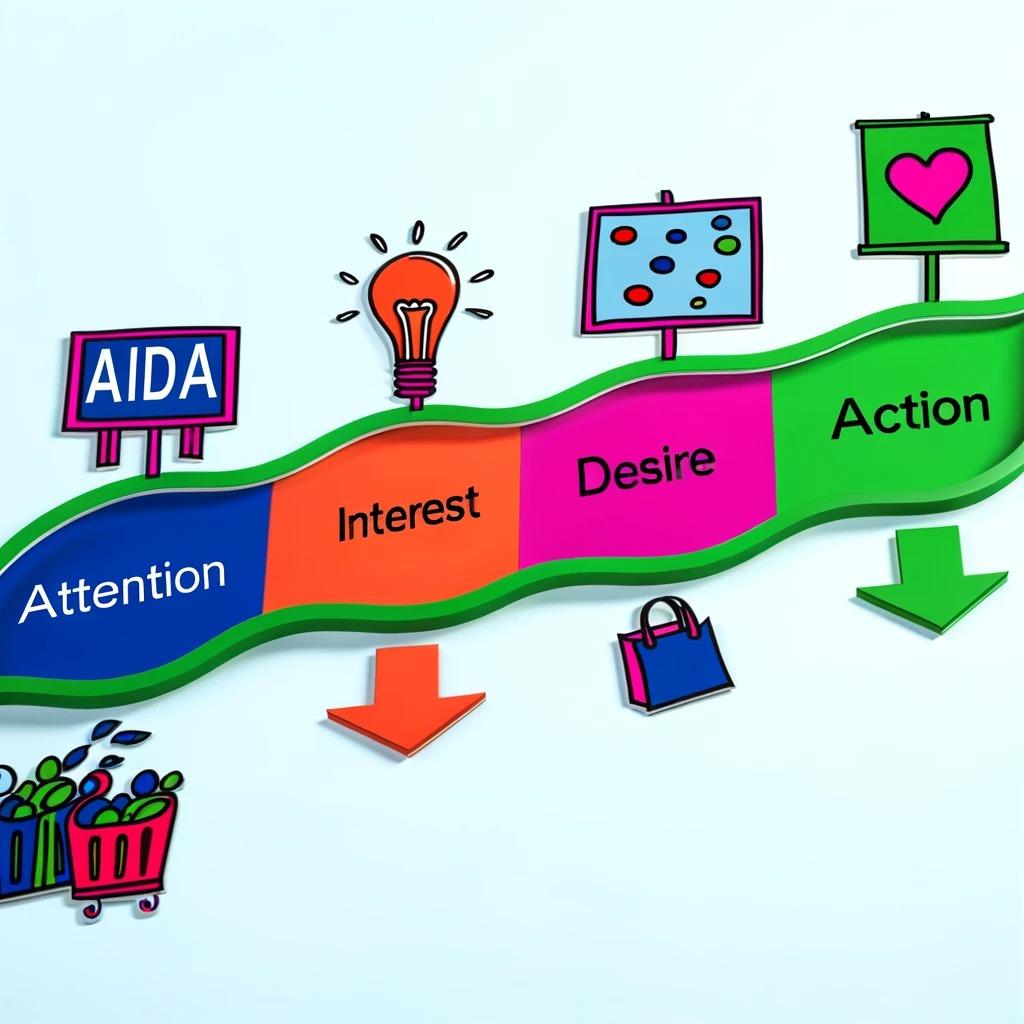Navigating the Consumer Mind is an insightful exploration into the complexities of consumer behaviour and the psychological factors that drive purchasing decisions. This article sheds light on the various influences that shape consumer preferences, from social and cultural dynamics to emotional triggers and cognitive biases. By delving into the intricacies of the consumer psyche, marketers and businesses can develop more effective strategies to connect with their audience, tailor their messaging, and ultimately influence buying behaviour.
This journey into the consumer mind offers a deeper understanding of the motivations and processes behind consumer choices, providing valuable tools for crafting impactful marketing campaigns and building lasting customer relationships.
At the heart of effective marketing strategies, understanding and applying the AIDA framework offers a blueprint for engaging consumers and guiding them through their purchase journey.
AIDA is a classic marketing framework that outlines the steps a consumer goes through before making a purchase. The acronym AIDA stands for Attention, Interest, Desire, and Action, each representing a step in the consumer’s journey from awareness to the final action of purchasing.
This conceptual framework is one of the cornerstones in the field of marketing and advertising. AIDA framework is attributed to American businessman Elias St. Elmo Lewis. In the late 19th century, Lewis conceptualised AIDA as a method to capture the stages a consumer goes through before making a purchase.

Application of the AIDA Model in Marketing Communication Funnel
- Attention: The first step is to grab the consumer’s attention. This can be achieved through various marketing channels such as advertising, social media, or email marketing. The mail goal at this astage is to make the target audience aware of the product or service. Most brands achieve this through digital advertisements, social media, billboards, or television commercials. The content is designed to be eye-catching and memorable, ensuring the brand stands out in a crowded marketplace.
For example, one of the most loved Indian brand ‘Amul’ effectively grabs attention through its topical and witty advertisements that often relate to current events. Amul’s topical advertising campaigns are current events to create engaging and humorous ads, capturing the audience’s attention with its witty content and distinctive visuals. - Interest: Once the consumer’s attention is captured, the next step is to generate interest by maintaining and deepening the consumer’s interest. This involves providing more information about the product or service and highlighting its benefits. Brands achieve this by highlighting product features, benefits, and differentiators. This stage involves educating the consumer about the product or service, often through targeted content like blogs, product videos, webinars, and detailed product descriptions.
Few apt examples of this could be Realme, a smartphone brand, generates interest by showcasing the advanced features and specifications of its phones in comparison to competitors. Likewise, Samsung India leverages detailed product demonstration videos and tech blogs to spark interest in its latest gadgets. By highlighting innovative features and technology, Samsung keeps potential customers engaged and interested in exploring more.
- Desire: The interest stage leads to the creation of desire; the brand now aims to create a strong desire for the product or service. This involves emotional engagement, showcasing the product’s ability to solve a problem, fulfil a need, or improve the consumer’s life. This is where the consumer starts to develop a preference for the product or service. Effective branding, emotional appeals, and social proof can contribute to this. Customer testimonials, case studies, and influencer partnerships can be particularly effective at this stage.
For instance, Tata Tea’s ‘Jaago Re’ campaign not only highlighted the product but also addressed social issues, creating a strong emotional connection and desire among consumers. Similarly, Real Estate companies like Lodha Group create desire by showcasing luxury living spaces through virtual tours and testimonials from satisfied residents. Highlighting amenities, location benefits, and lifestyle upgrades plays a crucial role in converting interest into desire.
- Action: The final step is to encourage the consumer to take action, such as making a purchase, signing up for a newsletter, or visiting a store. Clear calls-to-action (CTAs), limited-time offers, free trials, and easy checkout processes are strategies used to facilitate this step.
For example, brands like Amazon and Flipkart uses limited-time offers and discounts during its ‘Big Billion Days’ sale to prompt immediate action from consumers. They use flash sales, discounts, and easy EMI options to prompt immediate action. Their clear CTAs and streamlined checkout process further facilitate the decision to purchase.
The AIDA model’s effectiveness lies in its simplicity and adaptability, allowing brands to craft targeted strategies at each stage of the consumer’s journey. By understanding and applying this model, brands can improve their marketing communications, leading to better customer engagement and increased sales.




 Each title in our collection is more than just a book - it’s a ‘green gift’, promoting mindful reading, sustainable values, and a culture of eco-conscious living. By gifting books, you open doors to new ideas, support lifelong learning, and nurture a more informed, compassionate, and environmentally aware individual.
Each title in our collection is more than just a book - it’s a ‘green gift’, promoting mindful reading, sustainable values, and a culture of eco-conscious living. By gifting books, you open doors to new ideas, support lifelong learning, and nurture a more informed, compassionate, and environmentally aware individual.